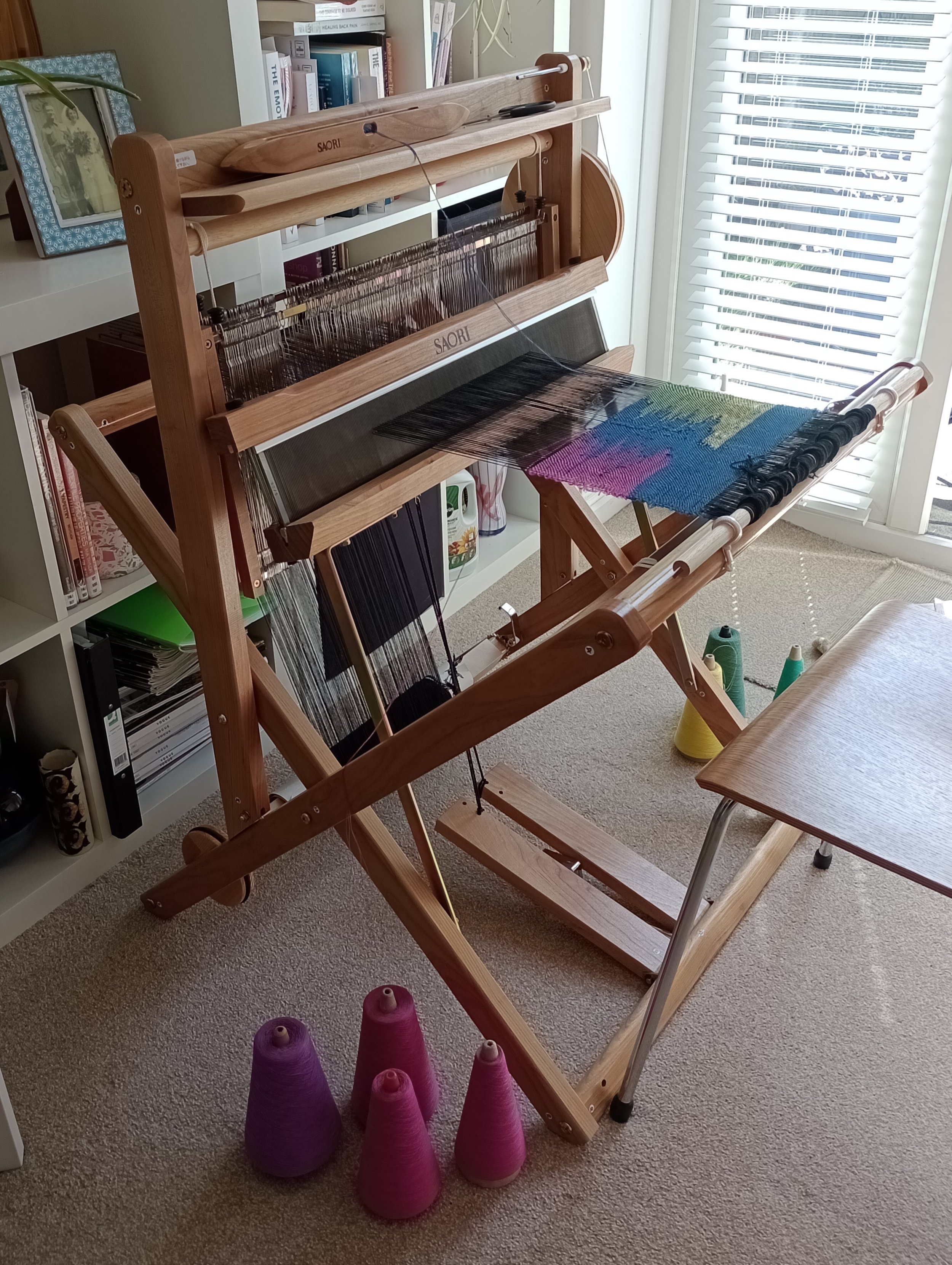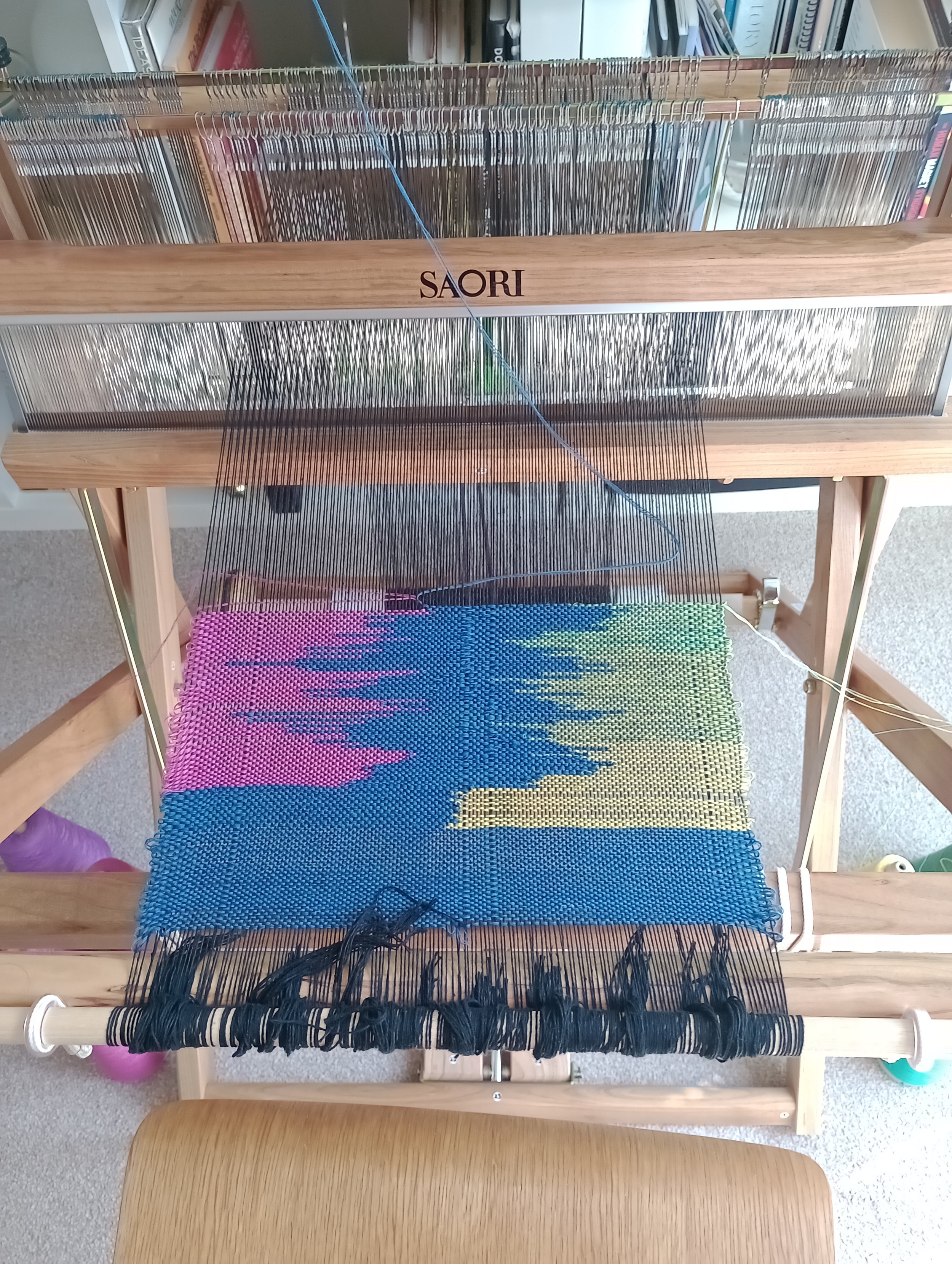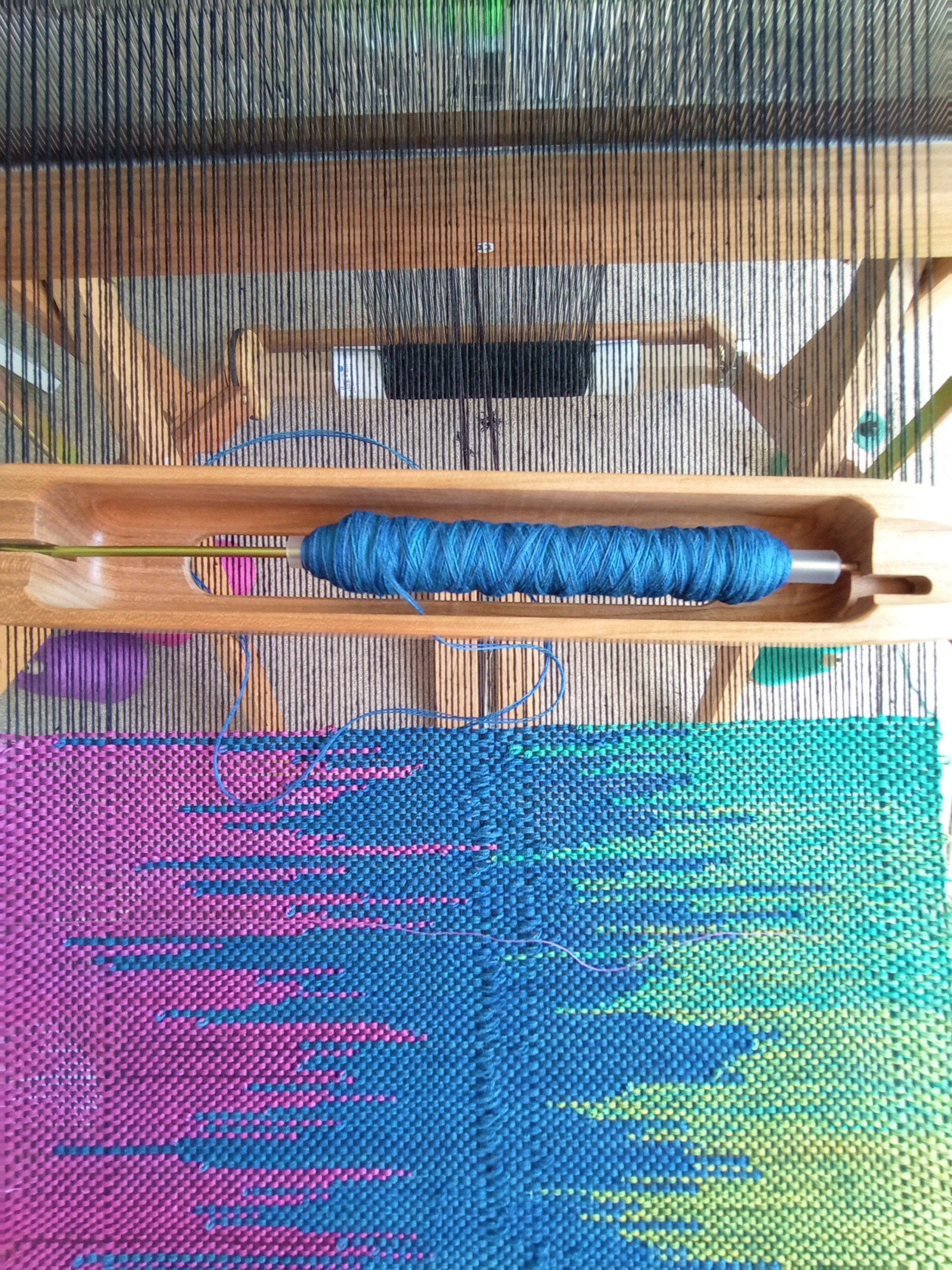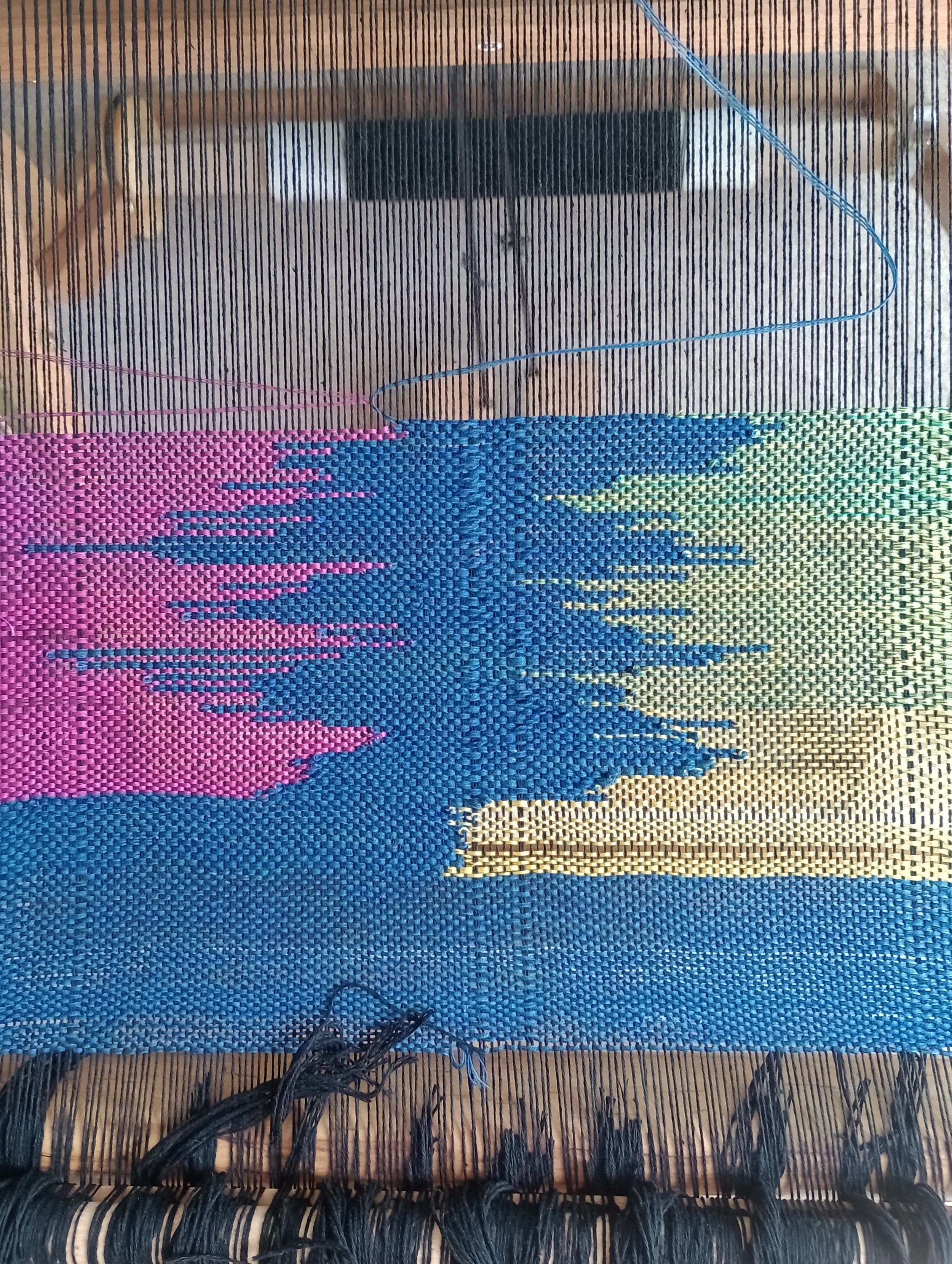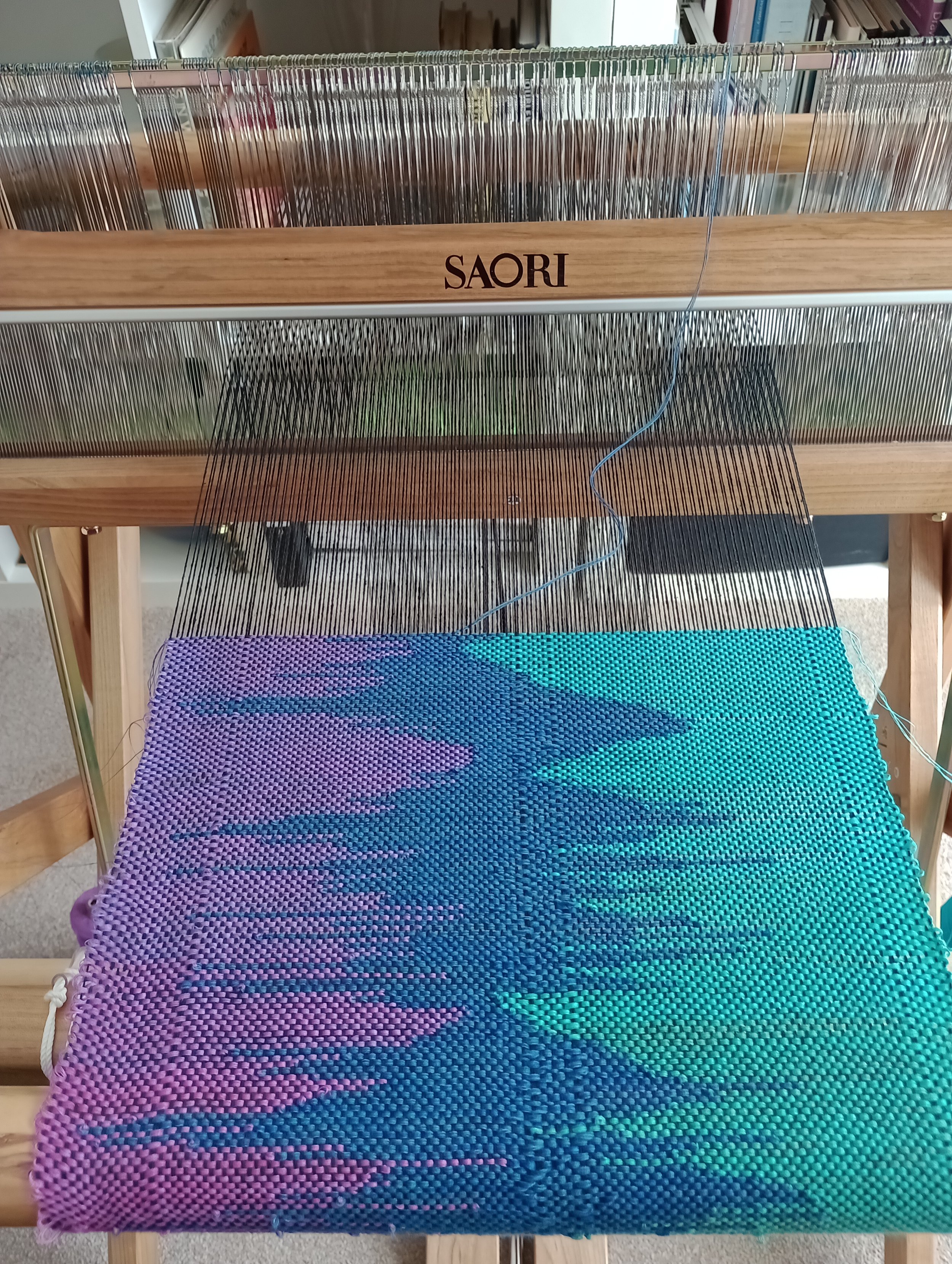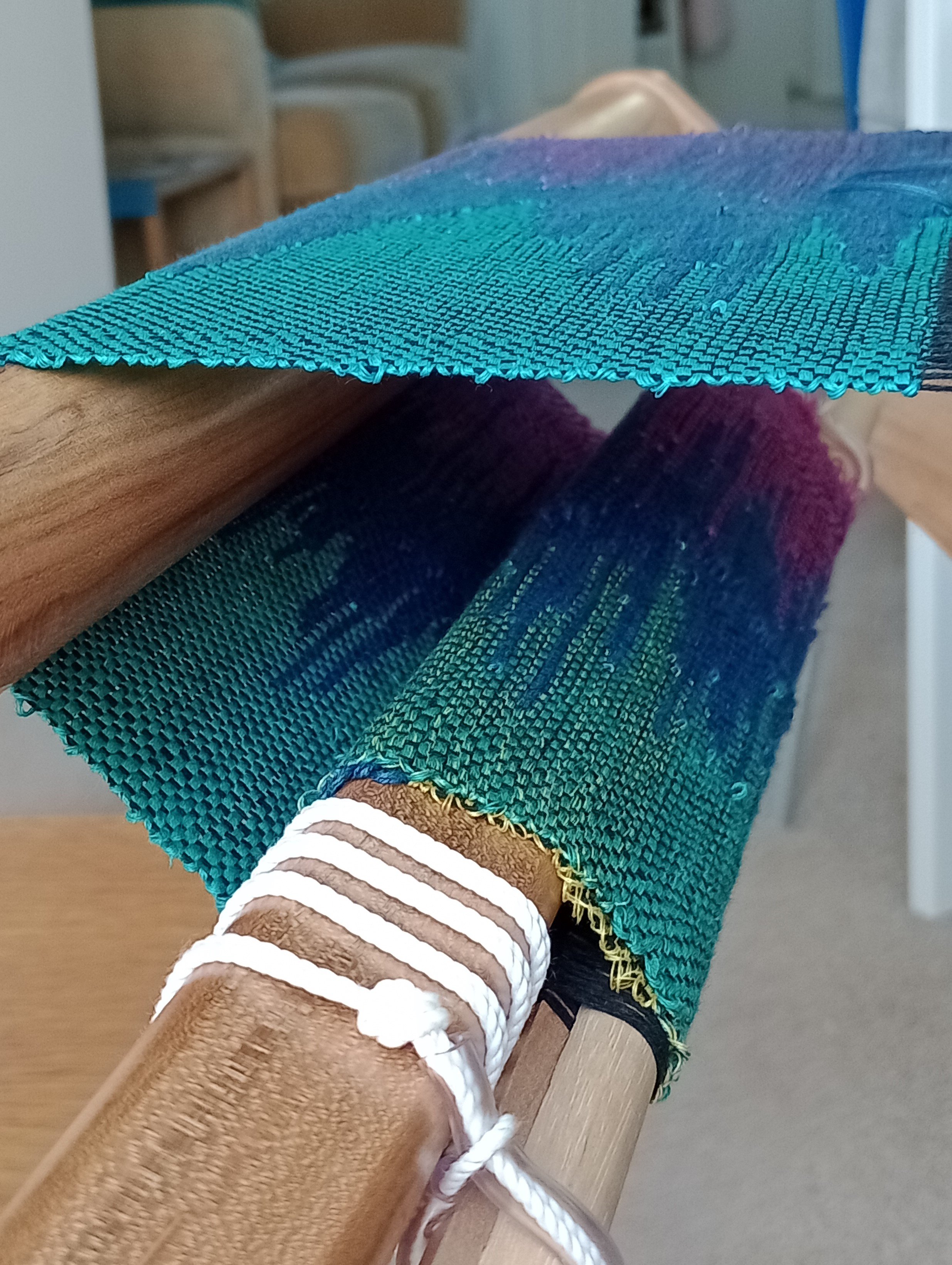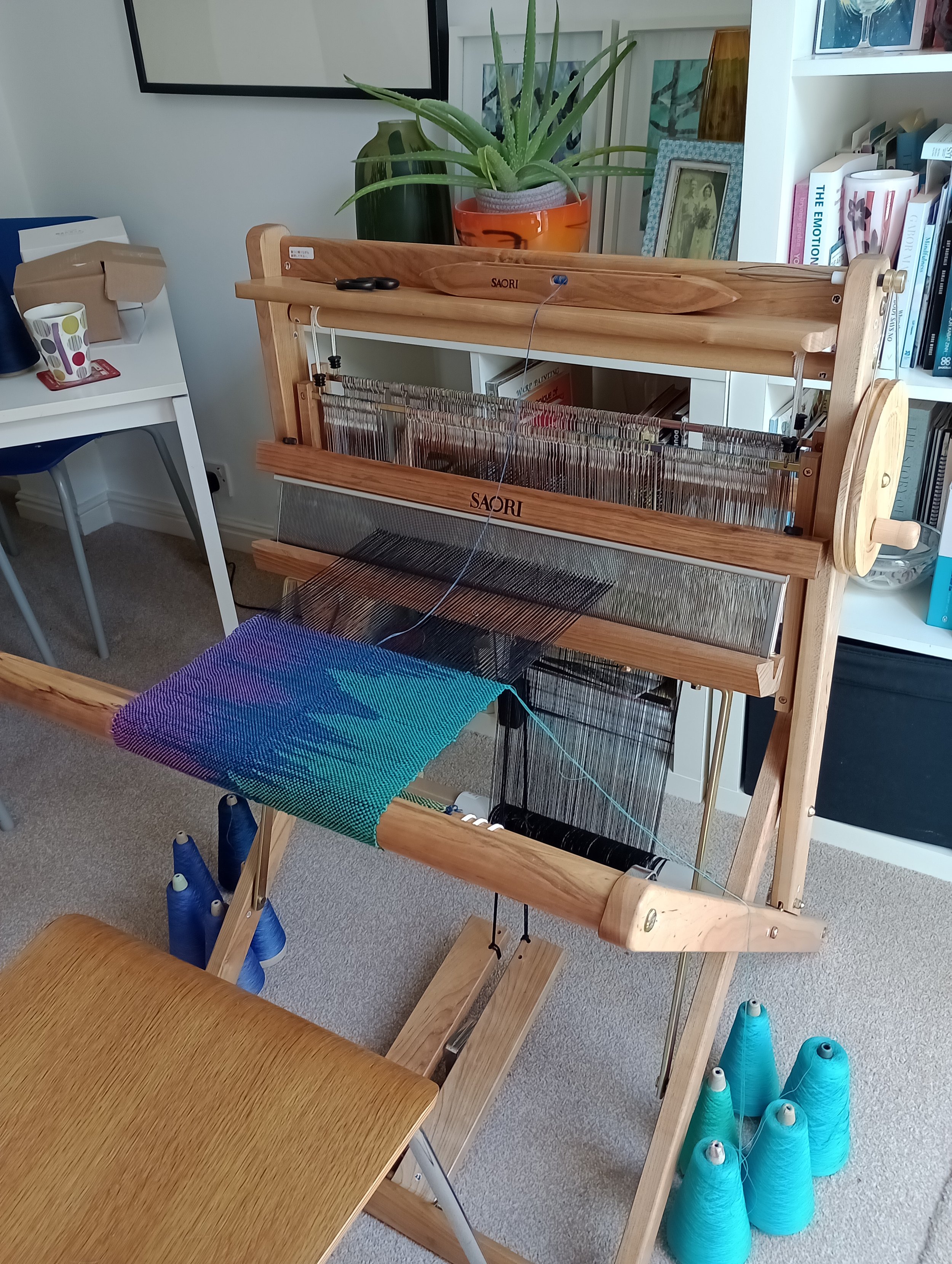New Loom
I collected my brand new SAORI WX60 weaving loom from Amanada of Beautiful Cloth Saori Studio from Napton on the 23rd May. Amanda had constructed the loom for me as it is shipped from Japan in separate parts. We had two hours together where Amanda showed me how to attach the warp and the threading process and we set up the loom together. I was really glad to be shown how to do this as the process is noticeably different to what I know from warping conventional looms. The Saori looms are designed to be as easy to use as possible, but for me that also involves unlearning things. Then, with some assistance, the loom was folded up, secured, carried out to my car and buckled into the back seat and I drove it home. Struggled a bit to carry it into the house by myself, but what’s a few bruises for the sake of art? I was really pleased that it did fit where I hoped it would in the living/dining room.
I am fortunate enough to have a room in my house that I use as a studio, unfortunately it’s already full with a floor standing Harris sample loom. I keep thinking I should sell it and make space for the Saori loom, but I can’t quite bring myself to make the decision as of yet. There are advantages to working from home as an artist, but sometimes I would really like a studio space too. My weaving and artistic practice is now taking over three rooms in the house as well as some of the garage. Things just don’t flow and work quite as well as I’d like and sometimes I would like things to be in their right place and rooms used for their correct purpose. Having the loom in such a prominent place in the house makes me feel like I should always be weaving! Perhaps this is just about adapting to a change in my immediate environment. Having said all of that, I know I’m fortunate to have the space I have, so I will work on making it work.
One thing that is really different about Saori weaving, is the ready made warps, that come wound on a tube ready to use. I noticed this was usually a black cotton warp, although I believe other speciality warps are available. I didn’t realise it was a deliberate choice that plain warps would be black, in fact it seemed like a difficult colour to me, especially when I wanted to weave in white. Then I read this on the Saori website,
Although we typically think of blank canvases as white, something that Misao Jo realized was that black warps allowed most colors to appear brightly while they might otherwise be muted on white warps. As a result, the black warps encouraged people to think less about which colors to weave with and follow their intuition more easily,… Saori Global - Looms and Resources
I find it interesting that a black warp allows the connection to intuition more easily than a white or coloured warp. We are so used to associating a blank piece of paper or a blank canvas as a white sheet, I wonder if drawing or painting on a black background would have a similar effect.
Weaving my first piece
The loom was all set up and ready for me to start weaving. I had to find yarns and make choices about what yarns, colours and materials I was going to use. I purchased a Sakiori fabric cutter along with the loom, because I would like to explore ideas around reusing old fabrics from clothes and other items and exploring the idea of identities and histories. However, I thought I would also need some yarns to get me started. Having spent most of the yarn budget on a Sakiori cutter, I resorted to looking in the five boxes of yarn I’ve had in the spare room forever. Most of these yarns came as a bundle when I bought my original loom back in 2006, so they are a mixture of colours and types. Some of these are bright coloured cottons that I thought would work well with the black warp. However, these yarns are very fine with thread counts of 2/40s and 2/50s, and not ideal for weaving on the Saori loom warp. So I used the technique of combining yarns to weave with, and this turned out to work really well. It enabled me to create some interesting colours with a depth and complexity that wouldn’t come from a single yarn. It also allowed me to switch individual yarns in and out to gradually change and blend colours. Needless to say I got really carried away by this idea and process that was emerging, and am still yet to explore the Sakiori.
The technique I explored in this first piece is clasped weft with three colours. I wound three different shades of blue yarn together onto a bobbin for the shuttle and used this throughout the piece. On either side of the loom, I placed the colours of yarn for the left and right sides of the weft. I started with around three yarns combined but gradually built up to around 5 or 6. I then developed my own technique of changing colours gradually by now and again replacing one colour yarn with another by cutting and tying it onto the previous thread. With the clasped weft technique, I randomly chose where to place the colours, creating a zig zag type movement through the centre of the piece. I also made the decision as I went to graduate the colours towards darker shades.
Some Thoughts
Slow pace - working at home has allowed me to work on my weaving at a slower pace. This did feel a bit frustrating when I was comparing it to how much I achieved during the day weaving workshops with Amanda. However I realise that with more time and a slower pace I am able to explore ideas and techniques more thoroughly with more depth.
Process, time and patience - allowing the process to take the time it needs. Sometimes with weaving, my mind wants to move onto the next thing, the next colour change or technique, or I start to get a feeling for how I want the piece to develop. I’ve found the process has a pace of its own. It can’t be rushed.
Slow expression -, the process of weaving does not show big, immediate expressions in the moment, for example like scribbling on paper or throwing paint at a canvas. This is because it is built weft by weft, row by row, incrementally.
Connecting with intuition Vs expressing emotion in the moment. - I realised I was confusing ideas about expressing emotions and self-expression with the idea of connecting to intuition. I do think these are linked, but they are not necessarily the same thing. Perhaps through ideas related to art therapy or abstract expressionism, I was relating the idea of expression needing to be something that happens immediately and quickly when you are in connection with it and perhaps being in that emotion whilst expressing it.
I’ve begun to see that intuition in creativity may come through very immediately, or not, but that, especially in this weaving process, what will come through, will come through at its own pace. Intuition is involved, but it may come through in stages or through the flow of being engaged in the making process. Or there may be parts when the physical process of making is having to catch up with the ideas or inspirations at a slower pace.
Intuition Vs overthinking - Getting caught in the trap of over thinking. Perhaps due to the slower pace I found the weaving process taking. I had time between creative decisions to over think the next move or the way I’d like the final piece to look. The question then arises, am I working from intuition or is a more rational, logical thinking process taking over. Being more aware of being able to tell the difference between the states is something I need to develop, both in weaving and in life!
How to know when it’s finished - how do you decide when enough is enough? When the warp is six metres long and you have no set size for the piece or a time limit to weave it in? I found myself getting impatient towards the end to find a way to round the piece off in a way I was happy with, but also reluctant to stop weaving too soon, in case I decided afterwards that it wasn’t enough. But also I find that pieces have a natural completion point, where it just feels right to finish.
Difficult second album - I've started weaving my second piece on the loom. I’m finding it difficult. It’s not flowing as easily. I’m more caught in overthinking and not knowing how to progress. I’ll write more on this in a future blog post, but what came to me was the concept of the difficult second album that musicians talk about. I felt my first piece was successful, almost surprisingly so. So now I feel under (internal) pressure to follow that up using similar materials, techniques and ideas.
Sharing before you are ready and giving yourself time to create and develop behind the scenes. - something that’s been on my mind recently is this. Artists and creatives can feel under a lot of pressure to share their process almost constantly for example on social media. Although I do want to share some of my process through this project and it was part of my original intention to do so, sometimes it doesn’t feel easy to me. So I’m experimenting with ideas around what to share, when, how much and most importantly staying in connection with how I feel about it.
To sum up, I was thinking today about how this time a year ago, this project was still a vague idea, not even given a full form or plan, and now a year on, I’m actually doing it. I still have to check in with myself now and again that this is a success and I made this happen because day to day, it doesn’t always feel that way.
If you would like to keep up to date with my progress throughout this project, please follow me on my blog and Social Media; Instagram @ameswibs, Twitter @amiwib, Facebook Amie Wiberley Textile Artist
Intuitive Threads is a personal research and development project by textile artist Amie Wiberley, Supported using public funding by Arts Council England.
Amie is a textile artist and holistic and creativity coach. Find out more at www.amiewiberley.co.uk. Sign up to the mailing list here.
Links
Intuitive Threads - www.amiewiberley.co.uk
